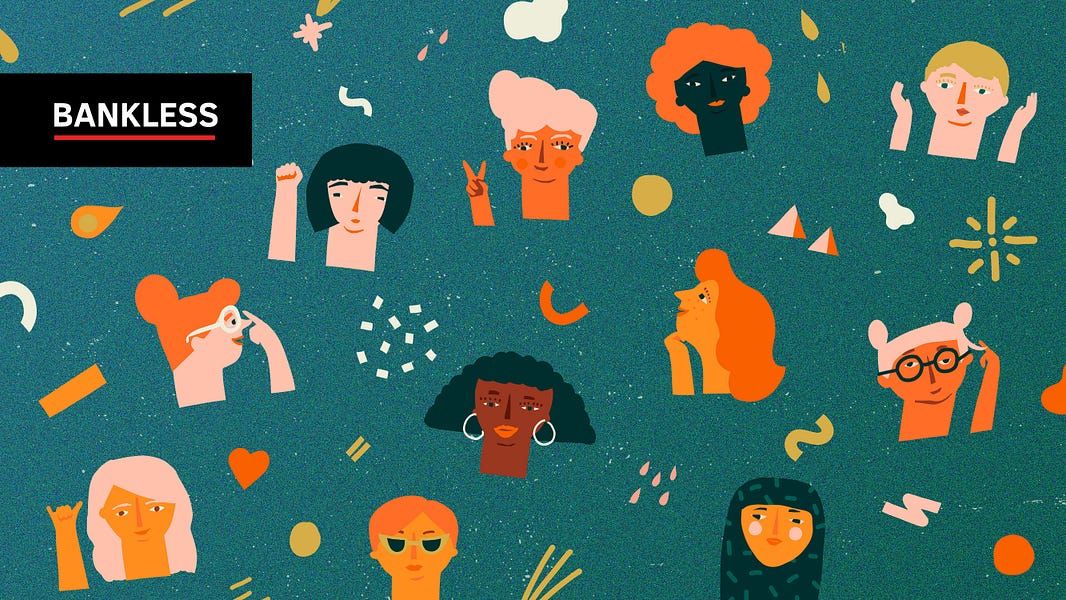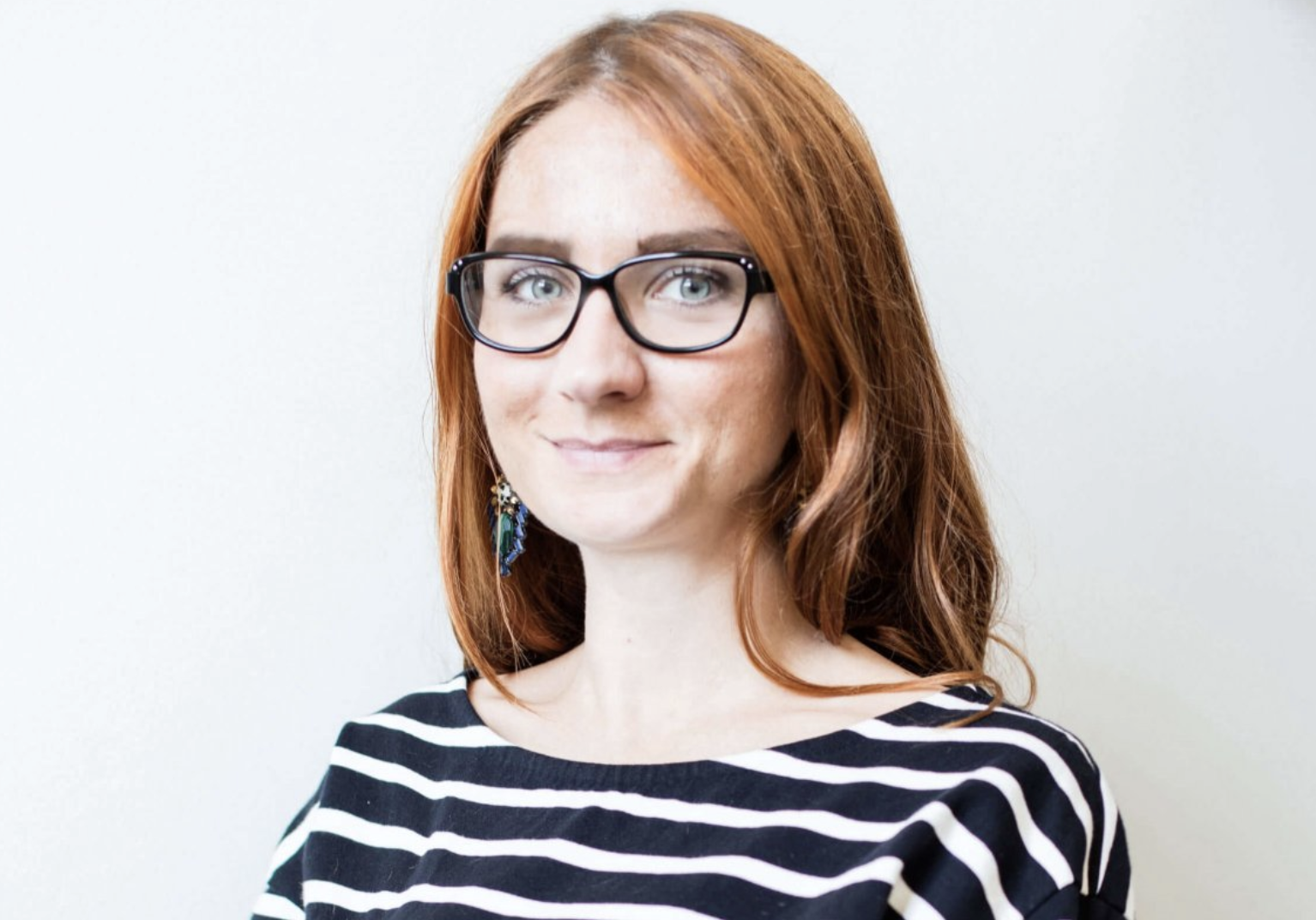6 reasons why there aren't more women in crypto

.png-a616dc52961c1edd72b0c1fdf5f47e7a.png-d44bdfd9b52d9f76131f38376a1fe385.png) Kraken - See What Crypto Can Be with Kraken
Kraken - See What Crypto Can Be with Kraken
Dear Bankless Nation,
Yesterday was International Woman’s Day.
It was awesome to see my Twitter feed light up with an appreciation for all the amazing women in crypto.
But at the same time, it was a grim reminder that there really aren’t that many women in the space.
It’s no secret that crypto is male-dominated. In a DAO survey that BanklessDAO did with Gitcoin, just over 11% of the hundreds of participants identified as female.
In a space as busy as ours, it’s easy to sweep the imbalance under the rug and say we’ll tackle it later.
But doing so narrows the mission of Bankless.
We can’t afford to miss 50% of the world.
We cannot fully extricate our population from the legacy financial system if our wives, girlfriends, sisters, daughters, mothers, and nieces are still stuck with their bank accounts.
Going Bankless is for everyone.
Samantha tells us what we can do about it.
- RSA
Shortly after joining BanklessDAO, I became the Talent Scout for the Writers Guild. I talked to hundreds of people who were interested in joining the guild. Of those, I could count the number of women on one hand.
BanklessDAO is technically thousands-strong, with probably around 500 active contributors and maybe a dozen women. This is not because BanklessDAO is inhospitable to women—on the contrary. The DAO is incredibly warm and welcoming.
Crypto as a whole has this problem.
Our space seeks to be inclusive to everyone—and I believe it can be. I believe the principles of this new internet of ownership will actually make the world a better place and open doors for people who haven’t yet had a seat at the table.
So, why aren’t women joining the crypto community? These are my six reasons.
1. Crypto often starts as a side hustle
Many people get into crypto as a hobby.
If they have time, it might even turn into a side hustle - contributing a couple of hours a week to a DAO, yield-farming, or flipping NFTs. All of these side-hustles are done after-hours, in the evenings, and on the weekends.
This side-hustle culture might attract more men than women because women of all generations are still largely responsible for childcare, housekeeping duties, grocery shopping, and meal prep. Married women with children dedicate nearly twice as much time to cleaning, childcare, and housework compared to their husbands.
Regardless of strides made to make women more equal in the workforce, they’re missing out on equality in the overlooked but essential realms of the kitchen, the living room, the laundry room, and the grocery store.
This sat strangely with me. Isn’t my generation the progressive, world-changing one? Aren’t we tossing aside those tired old gender norms? But even young couples still have this massive after-hours work imbalance in their homes. The further I researched this, the more it seemed that having a crypto side hustle just isn’t feasible for many women, especially those with children.
It’s shown in the side-hustle numbers, too. 46% of employed men report having a side-hustle, compared to 35% of employed women. And men make quite a bit more on their side hustles. An average monthly side hustle paycheck for a man is $2,708, but for a woman, it’s only $526. Side-hustles aren’t just more feasible for men who don’t take the house duties. For many possible reasons, they end up being much more profitable, too.
“Until Americans turn their attention to the home, where gender inequality remains deeply protected by old-school social norms, they will have an incomplete picture of the problem and incomplete solutions for addressing it,” wrote Aliya Hamid Rao for The Atlantic. In other words, if we don’t get real about what’s going on in the house, we won’t get women into Web3.
Crypto could bring women into the fold. We just need to find ways to make it feasible for women to jump into crypto full-time rather than having to take it on as a side gig. By creating full-time, paid roles for individuals who are outside of crypto or have one foot in the door but haven’t fully tumbled down the rabbithole yet, we’ll create more opportunities for women to join the crypto front lines.

2. Crypto is portrayed as the next generation of tech bros
The media is obsessed with one type of knowledge worker.
Male. White. Twenty-something. Rumpled t-shirt going on day three. In need of a haircut. Introverted, qualifies for the Mensa Society, and socially awkward in a quirky way. Created something that made him wealthy forever and ever. If we get lucky he’ll start donating it to clean water or something.
The problem isn’t that these guys exist—many of them are doing great work. The problem is that when this narrative is played over and over again, it can feel like there’s no space in it for women.
This narrative becomes a self-fulfilling prophecy. The “tech bro” becomes such an enduring trope that people can’t imagine life without him around, making some cool new startup that will bleed money for years before getting bought by a FAANG. They even start wearing those zip-up sweatshirts to look like a tech bro. And crypto falls right in line.

If crypto is painted as the new Silicon Valley, the crypto bro is painted as the new tech bro. The crypto bro might have some similarities to the tech bro (I’m sure they both need a haircut) but the ethos is still the same.
And when this narrative persists, it prevents girls and women from getting in the game. Not everyone wants to go around breaking glass ceilings and defying gender norms. It gets tiring. The media’s “tech bro turned crypto bro” narrative is creating a barrier for women getting into crypto. It’s a self-fulfilling prophecy—VCs see guys who look and talk like them, then they decide to fund them. And then more guys who look and talk like the original guys end up in the space, and it keeps spiraling.
But there can be space for women in this narrative. We don’t need to build an industry by and for crypto bros. In fact, try this, stop using the word “crypto bro” right now. We can demolish the old boys club culture of tech and hire women outside of crypto who just haven’t made the leap yet. By bringing in women for full-time work who may have soft skills, such as art, communication, writing, and project management, we’ll shatter the tech bro narrative and turn it upside down.
3. Crypto is for risk-takers and women aren’t encouraged to take risks
Studies show that women are more risk-averse than men. And crypto, as we know from the rollercoaster-like dips and pumps (as well as some keep-you-up-at-night-worthy regulatory uncertainty) that we experience on a weekly basis, is rather risky. But do women really feel that risk-averse that they can’t hold some blue-chip tokens?
“I've always felt crypto, in general, is also a male thing, since my first approach was through HODLing rather than trading,” said Ornella, a core member of BanklessDAO who contributes to International Media Nodes and Marketing. “To see women in the space was a very, very rare thing.”
While it is true that women engage in fewer high-risk activities than men, including everything from skiing to climbing to freediving, I think the issue goes deeper than simple risk-aversion. One study found that even though women are underrepresented in the high-risk sports of cliff diving and freediving, the women who are in those sports don’t show any fewer instances of sensation-seeking behavior, a form of risk-taking. In other words, women in those sports are just as risk-tolerant as men. There must be other factors at play.
One possible explanation is our socialization. From an early age, women are socialized not to take risks, while men are encouraged to do daring things. As a kid, I was in Girl Scouts and my brother was in Boy Scouts. While they went into the woods and threw knives at tree stumps, we Girl Scouts had a rule that we weren’t even allowed to run on pavement. We sat inside and filled in workbooks, while the boys went rock-climbing and camping for weeks. The risk-taking socialization goes even deeper. Girls watch movies and read stories about princesses stuck in castles, patiently waiting for the brave, risk-taking knight to go through all the conquests and come to save them. Many of our modern stories don’t follow this same trope, but they still draw inspiration from it.
So, we know that some women may be more risk-averse than some men. But I believe that socialization and society’s expectations of women contribute to the creation of risk-aversion more than anything else.
While it’s hard to change societal expectations and requirements, it’s easier to make changes at a smaller scale. Rewarding both men and women for the risks they take, and then encouraging more healthy risk-taking, is a great first step.

4. Crypto requires hard skills, like comp-sci and finance
Two of the primary industries that feed directly into crypto, finance and computer science, are both heavily male. According to a Preqin report on Venture Capital firms, women only make up 17.9% of the employees and 9.9% of the senior roles. And college majors in the hard sciences like physics, engineering, and computer science, still have four men to every one woman.
They’re heavily male for many reasons—men were historically pushed toward math, finance, and hard sciences. Boys are socialized to experiment with science and math-brain-oriented toys, like legos, at a young age. Gender norms, such as who is the “breadwinner” in the house, are trickier to erase than we think.
But crypto extends far beyond these hard skills. It’s just not well understood.
In BanklessDAO all core contributors have a toolkit of soft skills at their disposal. They’re communicators, writers, thinkers, artists, and readers. They’re not solely number-crunchers or people so deep into coding that they don’t come up for air. They’re people who are so much more multi-dimensional than that.
Crypto is getting more people with soft skills and from backgrounds that aren’t VC firms or Silicon Valley tech startups. Just look at the explosion of artists coming in through NFTs, or writers coming in to own their pieces via platforms like Mirror. We need to continue working actively to change the narrative of crypto as a place for only people who care about finance and computer science. It’s so much more than that.

5. Crypto is for people who only talk about money
Bankless touts crypto as an incredible wealth-generating opportunity. It’s exciting and people have made a lot of money. But compared to men, women shy away from talking about money, especially about moon shots that make crypto so attractive to so many people.
I’ve never talked about money with female friends. Unless we’re venmo-ing each other for dinner or complaining about paying rent, we’re not talking about money. We’re never talking about gaining money, either—we might be talking about what we wished we had, but never how we’re planning on getting it. I know many women have a similar experience, and it crosses generations. For example, I’ve never heard my mother talk about money with her friends, but I’ve often heard my father talk about stocks with his friends.
Maybe part of this is because women are characterized as excessive spenders and shopaholics in the media. High school girls with “daddy’s credit card” are ostracized. Women with money and power have been accused of getting there by “sleeping their way to the top.” A woman with money is not viewed in the same way as a man with money, and our culture shows it.
It’s possible that women don’t talk about money because of the way they’re treated when they do have money. It’s also possible that the old adage of men being breadwinners prevents women from talking about it.
So, how do we solve this in crypto?
We talk about the crypto things that are about more than money. But we also cultivate safe, healthy spaces for women to talk about money without feeling that they’re going to be criticized. We make it normal for women to talk about money, ask for raises, and climb the economic ladder. The open, free space of crypto means we can create a lot of these norms now.

6. Crypto is an anon-friendly space
Now that I’m deeper into crypto, I know that anons aren’t anon so they can hide from their past (unless you’re Sifu). Rather, they’re anon so they can create a new identity that better fits them in this new reality we’re all building. And I support that wholeheartedly—it makes crypto better that people can be comfortable in their own skin and their new identity.
But, when I was on the outside of crypto looking into this anon-dominated space, I was a little worried. Anon spaces have historically been hostile to women. Forums on anon-dominated platforms, like Reddit and FourChan are not places that women often traffic. I’m sure you’ve heard of movements like these. Anonymity is, unfortunately, one of the main tools that allow these movements to persist.
When I first joined a DAO and saw the sheer number of reddit-like names and avatar profile pictures, I took a step back and thought about what I was doing. Should I be here? I wondered. I knew they were mostly male—the voices in calls tell you that—and I wondered if this would be a welcome space. But as soon as I started joining calls, I knew that this was an anon space unlike any other. This was a welcoming and kind and warm space, not cold and hostile like ones I’d read cautionary tales about before.
Crypto has a marketing problem. It doesn’t know how to pull off the anon-space-vibe in a way that doesn’t feel chat-room-y and Reddit-forum-y.
Would going so far as professionalizing and, essentially, KYC-ing the space mean that we’d get more women involved? Maybe, maybe not. I’ve noticed that women tend to use their “real” names and “real” pictures on Discord and Twitter more often than men. But taking away the rich culture of anonymity would mean we lose a large piece of what makes crypto what it is.
I think that we just need to make it clear to more women that this anon space is not like the ones we’ve all heard about and stayed far, far away from. This is a welcoming, warm space that is inclusive to all. And, with some positive press and more and more women coming in, we can show that.
How to bring more women into crypto
Once more women join the space, it will create a positive feedback loop. Ornella observed this in BanklessDAO, saying that the growing number of women involved is “possible now since there were brave ones who stepped up at the very beginning when it was all men. They paved the way for new women to come by and get involved. That's one of the reasons why I stayed, and definitely a foundation to keep working on top of.”
But how do we kickstart this positive feedback loop? We can’t change deep societal problems. Unfortunately, on a daily basis, you and I are stuck with those. But, there are a few concrete steps you and I can take to bring more women into crypto.
- Hire outside the circle of crypto insiders: While it’s tempting to hire someone who’s been holding their bags since ‘16, if that’s your standard, you’re going to be hiring mostly men. Many women haven’t been in crypto that long, for the reasons I described above. However, these diverse perspectives are essential for a strong company, DAO, or protocol.
- Post jobs that are not side hustles: Not everyone can take on a side hustle. Many need a steady 9-5 that allows them to have time for childcare and housework. Offering full-time work will open doors for new groups.
- Talk to all your friends and family about crypto, not just the guys who bought GME on Robinhood. There’s a place for everyone in this industry, so when you’re onboarding your friends into crypto, don’t just onboard the dudes!
Crypto will be world-altering. But it won’t be world-altering until we have all genders involved. With an understanding of the possible barriers, we can make better paths to entry for individuals who haven’t made the leap yet.
If we’re going to onboard everyone to crypto, well, let’s get the other 50% of the population in here with us! Onward!
Action steps
- 🎧 Listen to Layer Zero with Boys Club on creating space for women in Web 3
- 📖 Read up on how to onboard your friends into crypto
- 👓 Check out Samantha’s previous article on Bankless
Author Bio
Samantha is a writer and editor for BanklessDAO. She loves thinking about the big questions of the human experience and finding out how Web3 fits in.
 Ryan Sean Adams
Ryan Sean Adams 
.png-a616dc52961c1edd72b0c1fdf5f47e7a.png-8359976fdb0656215e306b0de9208da8.png)